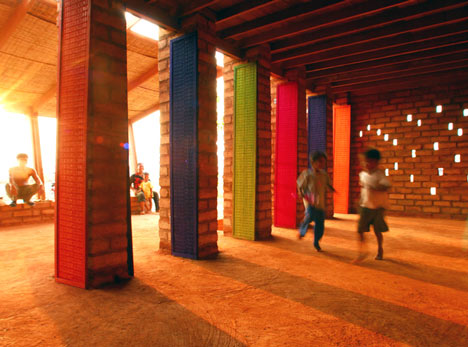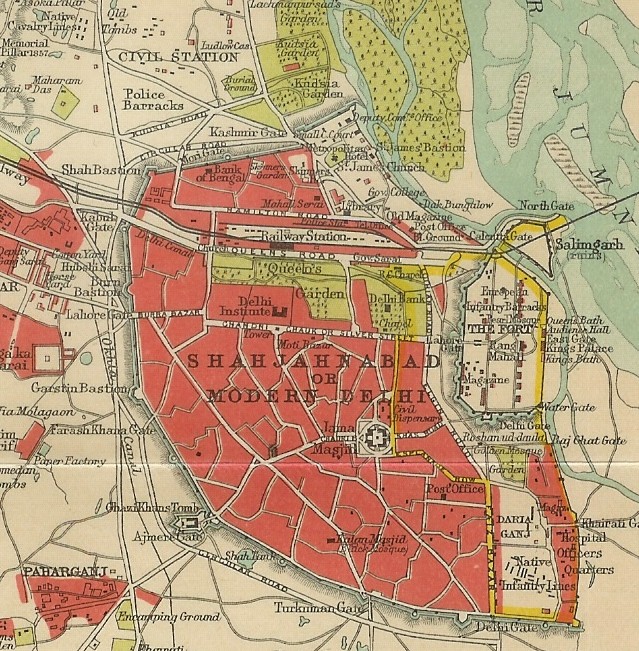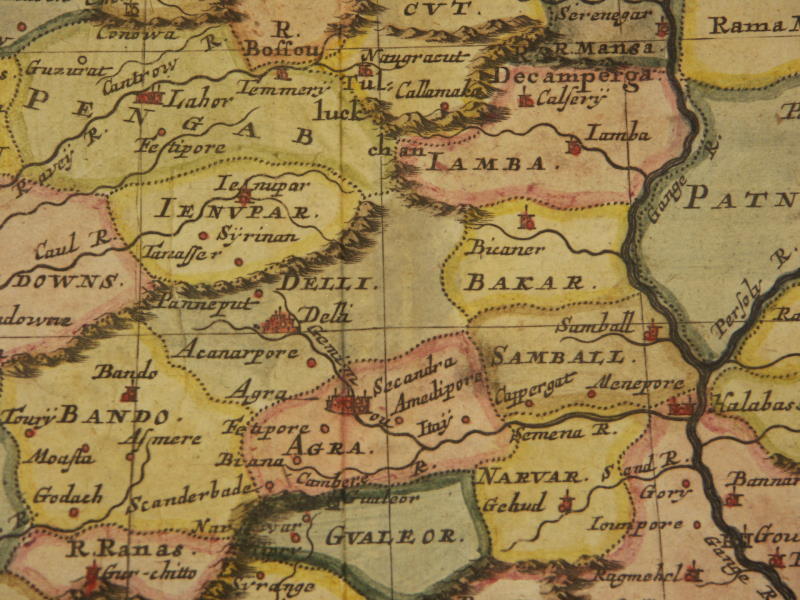///From Mughals to Moderns///
Starting from the Indus River Valley civilizations that began almost 5000 years ago, in what is present day Pakistan, and continuing to the formations of Mehrauli in the 8th century, Tughlakabad in the 13th century, Agra in the 16th century, Shahjehanabad in the 17th century, the British Raj New Delhi in the 19th and early 20th century and Chandigarh in the mid 20th century, India has supported some of the largest, most meticulously organized urbanization developments in human history.
And within these built environments we too find some of the greatest instances of architecture as well, impeccably scalable up to the larger urban visions that subsume them.
Though we will not be visiting Mohenjo Daro, our Critical Thinking class will culminate in the birthplace of the Indus River—the provenance of all Indus civilizations—where we will be employing the same 5000 year old technology used in Mohenjo Daro to construct contemporary architecture.
Prior to our visit to the himalayan region of Ladakh, we will begin our class in Delhi, examining its own historic 7 cities and the architectural remnants that survive, and proceed thereafter to the post-independence master-planned city of Chandigarh, for which Pandit Nehru (India’s first Prime Minister) commissioned the Prophet of the International Style, Le Corbusier.
Why visit a historical site to understand its history?
First of all, we are architects and operate continually at the human scale. Part of the experience of this historical journey will be to physically inhabit these urban and architectural schemes, to traverse their vast tracts and take solace in their cold marble and sandstone volumes in the heat of a Delhi summer.
Secondly, histories are continually dynamic narratives that morph according to the milieu recounting them. You must not accept history as unassailable dogma, as an inviolable object of infinite delicacy that cannot withstand penetrating criticality. Question the decisions of the architects and planners of these developments, and consider the implications of longevity and socio-historical instability on the built environment as you forensically discover the vestiges of past architectural interventions buried under centuries of inhabitation.
What architectures and/or urban plans were and were not successful? Why? What does modern day Chandini Chowk, Lutyens Delhi, and Chandigarh suggest about the plausibility of these grand design visions in a contemporary world?
Critical Thinking
The principal objective of this course is for the student to cultivate an ability to generate a clear, cogent critique of the phenomena they encounter corresponding with the built environment. And, really, what better place could there be to do so than in some of the most ambitious urban developments of the past 300-800 years?
An architect, or any critical thinker for that matter, can only ever generate a superficial critique of a given architectural event and the social milieu surrounding it by simply engaging such a physical entity through books and the internet alone.
Our interrogations will be first and second hand.
Students will be required to submit analytical essays prior to departing for India, as well as for delivering lectures of their findings at significant sites in India.
While travelling through Shahjahanabad, or Chandigarh, while marvelling (and wondering) at the exquisite power of the Taj Mahal, of Fatehpur Sikri and Jantar, students will compose analytical drawings that capture his or her own interests and reflections on site. Once the trip is concluded and we return to Bangkok, students will then be required to re-write their initial analytical paper, this time incorporating their personal experiences and critical reflections, and illustrating these with their analytical sketches.
This assignment relate in many ways to the journals of young Louis Kahn or Le Corbusier.
Blog created to support the work of a Design and Build for Community Workshop organized in North India by CL and TL for 24 students of INDA (International Program in Design and Architecture, Chulalongkorn University, Bangkok).
6.29.2011
6.28.2011
Detailed Schedule
Part I From Mughals to Moderns
Day 01. Thursday 30 june. Old Delhi
10.20 Arrival in Delhi; Check-in Hotel Livasa Inn;
13.00 Lunch near Karol Bagh (Pind Balluch)
14.00 Walk in Chandni Chowk, up to the Red Fort (visit) and Jama Masjid
20.00 Dinner in Chandni Chowk - Karim (to book (91-011) 23269880, 23264981)
Day 02. Friday 01 july. New Delhi
06.30 Group 1 Raj bike tour / Group 2 Jantar Mantar & breakfast at Andhra Pradesh Bhawan Canteen
10.00 Indira Gandhi museum + Gandhi Smitri
12.30 Lunch at Saravan Bhavan or at IHC (All American Dinner)
14.00 National Handicrafts and Handlooms Museum
15.00 Lodi Garden
16.30 Sunset at Humayun’s Tomb (closes at 18.00)
18.00 Back to hotel to freshen up
19.30 Dinner at Khan Market (Big Chill - Khan Chacha?) + ice cream at India Gate
21.00 Sound & Light show at Purana Qila
Day 03. Saturday 02 july. Day-trip to Agra and Fatehpur Sikri
10.00 Tughlaqabad Fort & Suraj Kund
13.00 Lunch in Merhauli or in Sakhet (on the way)
14.00 Visits in Merhauli: Qutub Minar, Jamali Kamali, Jahaz Mahal, Zafar Mahal, Lal Kot Wall, Step Wells...
19.30 Dinner at Gunpowder, Haus Khas village
Day 01. Thursday 30 june. Old Delhi
10.20 Arrival in Delhi; Check-in Hotel Livasa Inn;
13.00 Lunch near Karol Bagh (Pind Balluch)
14.00 Walk in Chandni Chowk, up to the Red Fort (visit) and Jama Masjid
20.00 Dinner in Chandni Chowk - Karim (to book (91-011) 23269880, 23264981)
Day 02. Friday 01 july. New Delhi
06.30 Group 1 Raj bike tour / Group 2 Jantar Mantar & breakfast at Andhra Pradesh Bhawan Canteen
10.00 Indira Gandhi museum + Gandhi Smitri
12.30 Lunch at Saravan Bhavan or at IHC (All American Dinner)
14.00 National Handicrafts and Handlooms Museum
15.00 Lodi Garden
16.30 Sunset at Humayun’s Tomb (closes at 18.00)
18.00 Back to hotel to freshen up
19.30 Dinner at Khan Market (Big Chill - Khan Chacha?) + ice cream at India Gate
21.00 Sound & Light show at Purana Qila
Day 03. Saturday 02 july. Day-trip to Agra and Fatehpur Sikri
AM Sightseeing tour of Agra, visiting the best of Mughal architecture such as Taj Mahal, Agra Fort and Itmad-Ud-Daulah's Tomb
PM Visit of Fatehpur Sikri / drive back to Delhi and transfer to the hotel
PM Visit of Fatehpur Sikri / drive back to Delhi and transfer to the hotel
Day 04. Sunday 03 july. Delhi
06.30 Group 2 Raj bike tour / Group 1 Jantar Mantar & breakfast at Andhra Pradesh Bhawan Canteen10.00 Tughlaqabad Fort & Suraj Kund
13.00 Lunch in Merhauli or in Sakhet (on the way)
14.00 Visits in Merhauli: Qutub Minar, Jamali Kamali, Jahaz Mahal, Zafar Mahal, Lal Kot Wall, Step Wells...
19.30 Dinner at Gunpowder, Haus Khas village
Day 05. Monday 04 July. Drive from Delhi to Chandigarh (238 Km)
PM Transfer to Sarao Group of Hotels (sector 63).
Day 06. Tuesday 05 july. Chandigarh
AM Sector 1: The Capitol = Secretariat, Assembly, High Court and, Governor’s Palace (LC) + monuments : Open Hand, Martyrs Memorial, Tower of Shadows
Lunch in a park (Rock garden)
PM Sector 10: Museum and Gallery of Art (LC); Sector 22d: Kiran Cinema (film?)
or
AM Sector 18: Tagore Theatre (Aditya Prakash), Secretariat Building (LC);
Lunch in a park (Rock garden)
PM Sector 14: Gandhi Bhavan (Pierre Jeanneret); Sector 12: Chandigarh College of Architecture (LC);
Part II On the road
Day 07. Wednesday 06 july. Drive from Chandigarh to Manali (350km)
Transfer to Tourist Hotel.
Day 8. Thursday 07 July. Drive from Manali to Sarchu (222km)
Transfer to Camps of Ladakh.
Day 9. Friday 08 July. Drive from Sarchu to Leh (257km)
Transfer to Oriental Hotel.
Part III Design Build for Communities in Leh (3 weeks)
Day 10. 09 July. Rest in Leh
Adjust to elevation in Leh, visit LAMO, the Leh Palace, explore the city, read, lectures, modeling workshop
Days 11 to 14. 10 to 13 July. Move to Tia
INTACH is supporting the community in restoring the old village temple and work on this will have commenced earlier in July.
We will be working with another NGO, SEEDS, who has been involved in post disaster reconstruction in Ladakh following the floods of last year. They will also be working in Tia and helping rebuild houses - as this will be actual construction using mud - either rammed earth or mud.
The temple space is not large so 24 students will not be able to work at a time there and we could split between the houses and the temple.
Days 14 to 18. 13 to 17 July. Move to Chiktan
Mud brick production in Chiktan / Stay in Ladakhi homestay
Days 19 to 21. 18 to 20 July. Chiktan
Documentation of Chiktan Fort
We will be working with Divay Gupta, a conservation architect for INTACH, Bhawna, a conservation architect in Tia, and Kacho Mumtaz, one of the co-governors of INTACH and the owner of the Chiktan Citadel!
Days 22 to 30. 21 to 29 July. Return to Leh
Design Studio for Adaptive Reuse of the Fort. Compile plans, sections and elevations of the original, and propose a new adaptive reuse Performing Arts center to both INTACH and the owners of the Citadel.
Organize an exhibition with LAMO
Day 31. Saturday 30 July. Flight Leh - Delhi
Fly from Leh to Delhi: 10:25-12:05
Pick up from Delhi airport and transfer to the hotel
SPA studio visit?
Day 32. Sunday 31 July
Transfer to the airport for Thailand or Individual travel
6.15.2011
Mud-brick school in Cambodia
A lovely project spotted for us by Aj Moe on Dezeen :
http://www.dezeen.com/2011/06/15/sra-pou-vocational-school by-rudanko-kankkunen/
http://www.dezeen.com/2011/06/15/sra-pou-vocational-school by-rudanko-kankkunen/
6.12.2011
Names of Delhi
Hello all!
As you are reading and discovering about our first stop, the fascinating and complex Delhi, i thought it would be a good idea to step by step write our discoveries down...
Here, now, the successive cities today called Delhi:
NAME BUILT BY DATES
As you are reading and discovering about our first stop, the fascinating and complex Delhi, i thought it would be a good idea to step by step write our discoveries down...
Here, now, the successive cities today called Delhi:
NAME BUILT BY DATES
- Indraprastha Pandava brothers 1500-1000 BC
- Dhillika Tomar Rajput VIII century
- Qila Rai Pithora Prithviraja III Chauan end of XII century
- Siri Ala-ud-Din Khilji XIV century
- Tughluqabad Ghiyas-ud-Din 1321-1323
- Jahanpanah Mohammed Tughluq 1325-1351
- Firoz Shah Kotla Firoz Shah Tughluq 1351-1388
- Purana Qila Sher Shah Suri 1540-1545
- Shahjahanabad Shah Jahan 1638-1648
- New Delhi British Empire 1920-1930
Those cities (which make one) had different locations, starting with Indraprastha, a modest city by the Yamuna river built by the hindu brothers Pandava, then moving south during the Rajput Dynasties, before slowly ascending north.
It is interesting to know that the capital has been moved away from Delhi several times; the first being in 1504, when Sikandar Lodi (2nd ruler of the Afghan Lodi Dynasty), in reaction to the difficulties Delhi was encountering after the death of Firoz and the brutal invasion lead by Timur, decided to set himself in Agra.
In 1638, after 80 years of desertion, Shah Jahan decides to go back to Delhi.
Delhi becomes the Empire capital, and the construction of Shahjahanabad begins.
In Delhi, we will be staying in the north, not far from Shahjahanabad, now called Old Delhi and we will walk its intricate streets on our first afternoon.
more Dehli maps here
more Dehli maps here
More soon.... you are obviously welcome to comment/add etc.
6.01.2011
Our Schedule Part I (revised)
So, some of you have been wondering the precise breakdown of our days in India. Here you go:
Day 1 - 30 June 2011: Departure from Bangkok (06.50 am) Arrive Delhi (10.20 am) - Old Delhi
Day 2 - 01 July 2011: day trip to Agra and Fatehpur Sikri
Day 3 - 02 July 2011: In Delhi - New Delhi
Day 4 - 03 July 2011: In Delhi - Very Old Delhi
(Stay in Delhi total 4 nights)
Day 5 - 04 July 2011: Drive from Delhi to Chandigarh (238 Km.). Transfer to Hotel. Overnight at hotel.
Day 6 - 05 July 2011: In Chandigar free for own activities. Overnight in hotel.
Day 7 - 06 July 2011: Drive from Chandigarh to Leh via Manali (350km). Stay one night in Manali.
Day 8 - 07 July 2011: Drive from Manali to Sarchu (222km.) and transfer to the hotel.
Day 9 - 08 July 2011: Drive from Sarchu to Leh (257km.). Transfer to the hotel.
08 - 30 July 2011: at Leh for Design build workshop ( 22 nights)
Day 31 - 30 July 2011: Return to Delhi by plane. Afternoon in Merhauli. Stay one night in Delhi.
Day 32 - 31 July 2011: Return to Bangkok (12.15)
Subscribe to:
Posts (Atom)




